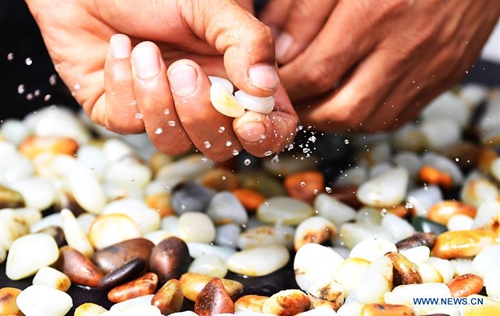Northwest China’s Xinjiang opens new museum in Hotan Prefecture
Source:Xinhua Published: 2020/5/19 18:08:40

A merchant displays Hotan jades at Hotan jade trading market in Hotan Prefecture, northwest China's Xinjiang Uygur Autonomous Region, May 16, 2020. The market has reopened recently under COVID-19 prevention and control measures. (Xinhua/Sadat)
The Hotan Museum officially opened to the public on Monday in Northwest China's Xinjiang Uygur Autonomous Region.
The museum, converted from a cultural center, is the first in Hotan Prefecture. More than 1,300 precious cultural relics are on display, many of which tell the history of the ancient Silk Road.
Hotan, located on the southern edge of the Tarim Basin, is a historical place where East met West along the ancient Silk Road.
The Hotan Museum thus enjoys the privilege of having an admirable collection of cultural relics, ranging from bronze wares to ancient books.
The relics on display also irrefutably prove that Xinjiang has been an inseparable part of China since ancient times.
Among them, the one most appealing to visitors is a piece of brocade with eight Chinese characters that literally read "Five stars rise in the East, benefitting China."
In 1995, archaeologists discovered the brocade in a tomb of Niya ruins in Minfeng County, Hotan Prefecture. The brocade was designated as a national treasure shortly after it was unearthed.
"There are five-star patterns and auspicious birds and animals. The words 'Five stars rise in the East, benefitting China' were woven between the patterns," explained Wang Xinyu, a guide with the Hotan Museum.
Yu Zhiyong, curator of the Museum of the Xinjiang Uygur Autonomous Region, gave a special lecture in the Hotan Museum on the excavation and protection of the brocade as well as progress in its study.
Monday marked this year's International Museum Day with the theme of "Museums for Equality: Diversity and Inclusion."
The museum was built with assistance from the Beijing Municipality, which is working with Hotan according to a pairing assistance program initiated in 2010 to support Xinjiang in building new infrastructure and promoting local development.
Posted in: ART,CULTURE & LEISURE